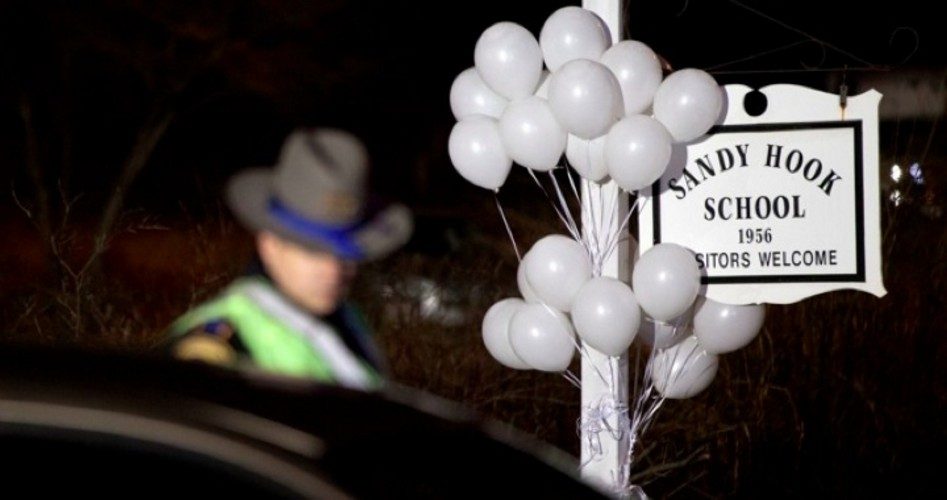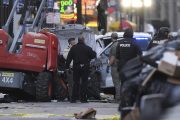
New information from police investigating the school shooting in Connecticut indicate that the gunman, 20-year-old Adam Lanza, forced his way into the school on the morning of December 14, killing two school officials as they tried to stop him from making his way to classrooms filled with children. After shooting the principal, 47-year-old Dawn Hochsprung, and 56-year-old Mary Sherlach, the school’s psychologist, Lanza proceeded to at least two classrooms, armed with a semi-automatic rifle and a pair of handguns, where he killed 20 children and the four teachers who were trying to protect them.
Law enforcement officials initially said they thought Lanza had been been buzzed into the school by Hochsprung, but it now appears that he breached school security by shooting through a glass door at the entrance, before going on his deadly rampage.
“We’re doing everything we need to do to literally peel back the onion [of the investigation], layer by layer,” State Police spokesman Lt. J. Paul Vance said at a news conference. He said they now know that Lanza “was not voluntarily let into the school. He forced his way in.”
The Los Angeles Times reported that Lanza began the day by killing his mother, Nancy Lanza, in the home they shared, before driving to nearby Sandy Hook Elementary School, where he used firearms belonging to his mother to kill his victims. While it is not clear how many firearms were used, investigators said they found at least one semi-automatic rifle and two handguns at the school, all of them tied to the assault.
According to the New York Times, investigators said Lanza shot his victims, “first from a distance and then at close range, hitting some of them as many as 11 times, as he fired a semiautomatic rifle loaded with ammunition designed for maximum damage.”
Connecticut State Medical Examiner H. Wayne Carver II said autopsies revealed that most of the children, between six and seven years old, had been shot more than once, saying the wounds were “all over.” He emphasized that they were “a very devastating set of injuries.”
From all indications, the adults killed in the incident died in heroic fashion, giving no thought to their own well-being as they attempted to save the children under their care. “The Newtown school superintendent said the principal and the school psychologist had been shot as they tried to tackle the gunman in order to protect their students,” reported the Times.
In addition to Hochsprung and Sherlach, the teachers who lost their lives were identified as Rachel Davino, 29; Anne Marie Murphy, 52; Victoria Soto, 27; and Lauren Rousseau, 30, who had just begun as a full-time teacher at the school in September after serving for several years as a substitute. “It was the best year of her life,” her mother told the Danbury, Connecticut News-Times in a story about her daughter’s life.
The New York Times reported that upon hearing the first gunshots, first-grade teacher Victoria Soto shepherded her first graders into closets and cabinets, “and then, by some accounts, told the gunman the youngsters were in the gym.” A relative told ABC News that Soto died as she “put herself between the gunman and the kids. She lost her life protecting those little ones.”
Contrary to earlier reports, there appeared to be no direct link between Lanza’s mother and the school. “Investigators said they believe Adam Lanza attended Sandy Hook many years ago, but they had no explanation for why he went there Friday,” reported the Associated Press. “Authorities said Adam Lanza had no criminal history, and it was not clear whether he had a job.” It did appear, however, that Lanza may have suffered from a personality disorder, and may have been diagnosed with Asperger’s, a mild form of autism. It was also reported that the young man was upset over his parents’ 2009 divorce.
One classmate said that Adam Lanza was “always different — keeping to himself, fidgeting and very quiet. But I could always tell he was a super-smart kid, maybe just socially awkward, something just off about him.”
In a statement Lanza’s father, Peter Lanza, said: “Our family is grieving along with all those who have been affected by this enormous tragedy. No words can truly express how heartbroken we are. We are in a state of disbelief and trying to find whatever answers we can.”
Predictably, the tragedy has ramped up renewed rhetoric about federal gun control. Shortly after the shooting the Coalition to Stop Gun Violence organized a protest in front of the White House, with participants chanting that “Today is the day” to move ahead with federal restrictions. The gun control group declared in a press release that “Americans must demand immediate action by our President and Congress to reform our gun laws. This must include legislation requiring background checks on all gun sales, strengthening those background checks … and renewing the ban on military-style assault weapons and high-capacity ammunition magazines.”
While avoiding the highly politicized issue in his initial remarks about the killings, President Obama nonetheless made a subtle suggestion that the federal government would have to do “something” in response to what he portrayed as an epidemic of gun violence. “As a country, we have been through this too many times,” said Obama. “Whether it’s an elementary school in Newtown, or a shopping mall in Oregon, or a temple in Wisconsin, or a movie theater in Aurora, or a street corner in Chicago — these neighborhoods are our neighborhoods, and these children are our children. And we’re going to have to come together and take meaningful action to prevent more tragedies like this, regardless of the politics.”
In the hours after the tragedy White House spokesman Jay Carney avoided addressing the issue of gun control when pressed by reporters. “I think that day will come,” he said, “but today’s not that day, especially as we are awaiting more information about the situation. I really encourage all of us to give a moment here to focus on what is an unfolding tragedy in Connecticut, and not to engage in Washington policy battles of long running today.”
Nonetheless, according to CNN, Carney said Obama is planning a renewed push for the ban on so-called “assault”-style firearms — a long list of semi-automatic rifles that are designed to look like fully automatic military weapons, but function as conventional rifles. Implementing such a ban “does remain a commitment of his,” said Carney.
Gun control advocates in Congress quickly took the White House cue, raising a chorus for such a ban. “We cannot simply accept this as a routine product of modern American life,” wept U.S. Representative Jerrold Nadler (D-NY). “If now is not the time to have a serious discussion about gun control and the epidemic of gun violence plaguing our society, I don’t know when is.”
CNN recalled that in 1994 Congress passed a limited ban on some of the rifles, noting that the prohibition, “which expired in 2004, did not eliminate them, but restricted their features, limiting magazine capacity to 10 rounds and regulating pistol grips, bayonet attachments, and flash suppressors.”
But in a December 15 commentary on the Connecticut shooting Larry Pratt, head of the Second Amendment group Gun Owners of America, argued that the tragedy, and others like it, are the result of federal laws that have made schools and other public places “gun-free zones.” Pratt wrote that the blood of those killed “is on the hands of members of Congress and the Connecticut legislators who voted to ban guns from all schools in Connecticut (and most other states). They are the ones who made it illegal to defend oneself with a gun in a school when that is the only effective way of resisting a gunman.”
Pratt noted that all of the mass murders where guns were used in the past 20 years occurred in supposedly gun-free zones. Had the principal, a teacher, or other school employee been armed at Sandy Hook Elementary School on that Friday morning, some have suggested, many of those who perished might have survived, with the gunman being killed before he had a chance to commit so much carnage.
“Hopefully the Connecticut tragedy will be the tipping point after which a rising chorus of Americans will demand elimination of the Gun Free Zone laws that are in fact Criminal Safe Zones,” wrote Pratt. “One measure of insanity is repeating the same failure time after time hoping that the next time the failure will turn out to be a success. Gun Free Zones are a lethal insanity.”
Photo: AP Images
Related articles:
Gun-free Zones Called “Magnet for Mass Shooters”
China School Knife Attack, Portland Mall Attack Receive Little Coverage



